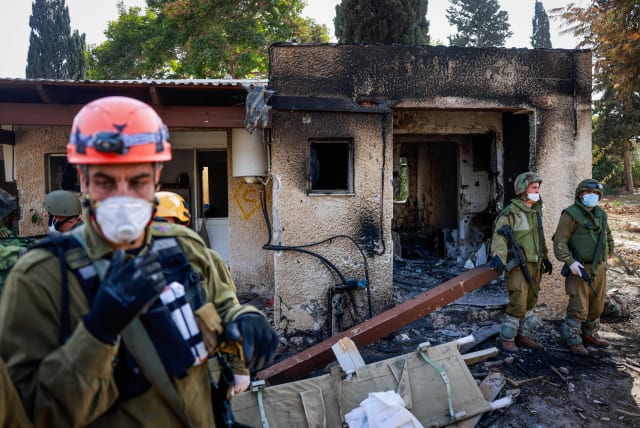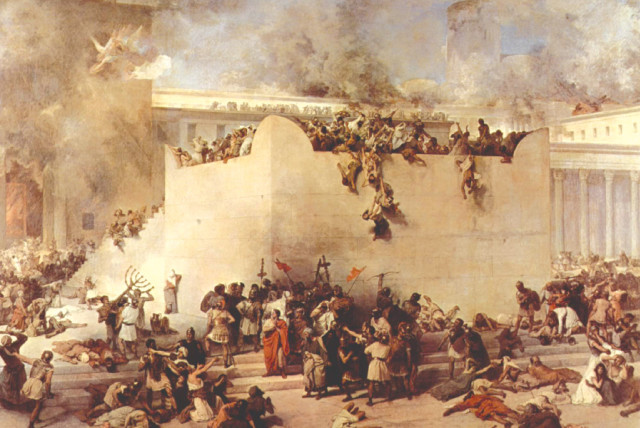The spiritual risks of lingering in the place of our pain

Grief on the scale of the fall of Jerusalem ultimately requires a vessel that both honors and contains it.
How often have I sat in my tears over these last weeks? How many minutes have I spent in the ruins — the ruins of people’s lives, the ruins of fixed ideas, the ruins of hope. I keep my eyes on my inbox and watch as people jump to the doing, the rallying cries and the articulation of positions. Some of these seem sensible, some are frightening. But even when I agree with them, the words don’t change the feeling. Because I am not there yet. I am still crying in the ruins.
A story from Talmud comes to mind. In the course of a conversation about the proper circumstances for prayer, we are told about Rabbi Yosei ben Chalafta, who is visiting Jerusalem when the time comes for the afternoon prayer. So he ducks into a ruined house. This was the century following the Roman conquest of Jerusalem. Ruin was the landscape.
Rabbi Yosei begins his prayer but notices that he is being watched. It is the prophet Elijah, standing guard. When the prayer ends, the prophet scolds the rabbi for praying in a ruin. He should have prayed on the road, Elijah says. Rabbi Yosei explains that he was afraid of being interrupted by travelers and would have been unable to concentrate. But Elijah says he should have done it anyway.
Why? Why not pray in the quiet privacy of the ruin? The Talmud explains that there are dangers there. Demons may attack you. There is a risk of prostitution or lewd behavior. And there is the obvious fear that the physical structure could simply collapse on top of you.
The Talmud articulates this as a worry about physical risks. But I think the sages might have been just as concerned about the spiritual risks of lingering in the place of our pain. They are worried that we might be further harmed, or we might fetishize our trauma or become trapped in it altogether and unable to escape. So keep moving, the prophet seems to say. Let your prayer practice bend to the momentum. If you have to, offer a short version of your prayer to be done quicker. Just don’t linger in the memory of destruction.
Grief on the scale of the fall of Jerusalem ultimately requires a vessel that both honors and contains it. This vessel ultimately came to be the fast of Tisha B’Av, when we gather as a community to mourn. We pull the Book of Lamentations from the shelf and weep and chant our way through it. This is the frame that both expresses and contains our ancient grief. How long did it take our ancestors to reach a place where containment of that grief was possible?
Struggles from the [past
A couple weeks ago, I attended an event for an AIDS service organization that I ran in the 1990s. Four decades have passed since its founding and the HIV epidemic is no longer an unceasing hammer of destruction. I walked into the ballroom and saw the faces of people I knew back when and I pictured the faces of people who are now long gone. Almost instantly, I was back in the ruins. I listened to the speeches and nibbled the hors d’oeuvres, but I struggled to contain my grief. Elijah might have told me to hit the road, but I didn’t want to run. The sadness was breaking my heart, but it was sweet too. Feeling the absence of old friends and colleagues was akin to feeling their presence; my grief was another flavor of love.
The Talmud also has mixed emotions about that sad place. Elijah reprimands Rabbi Yosei ben Chalafta for praying in the ruin, but in fact no actual harm befell him. So while this story is a scold, it is not clearly a cautionary tale. And more, the Talmud admits that there is a sweetness to praying in the ruin.
After a beat to change gears, Elijah asks the rabbi, “What did you hear while you were praying?” Rabbi Yosei responds that he heard a bat kol, a heavenly voice, and it was cooing like a dove. Elijah leans in further, and the rabbi tells him that the heavenly voice spoke words, saying, “Alas for my children, because of whose sins I destroyed my house and sent them into exile.”
Elijah excitedly tells Rabbi Yossei that such a voice cries out those words three times a day, every day. But the fact is that it was only here, in the brokenness of the broken building, that Rabbi Yosei was able to hear God’s own lament. In the ruin, he felt a divine companionship that was not obvious to him elsewhere. As Psalm 34 says, “God is close to the brokenhearted.” Perhaps that is the attraction of the ruin, that in our deepest grief we most clearly hear tza’ar hashechinah, the sorrow of the divine, cooing like a dove.
So when we find ourselves in the ruins, in the place of deep brokenness, we must remember to get out. And also to stay. For it is in the ruin that we and God cry together.
Jerusalem Post Store
`; document.getElementById("linkPremium").innerHTML = cont; var divWithLink = document.getElementById("premium-link"); if (divWithLink !== null && divWithLink !== 'undefined') { divWithLink.style.border = "solid 1px #cb0f3e"; divWithLink.style.textAlign = "center"; divWithLink.style.marginBottom = "15px"; divWithLink.style.marginTop = "15px"; divWithLink.style.width = "100%"; divWithLink.style.backgroundColor = "#122952"; divWithLink.style.color = "#ffffff"; divWithLink.style.lineHeight = "1.5"; } } (function (v, i) { });

